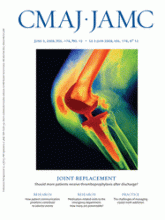- © 2008 Canadian Medical Association
Thromboprophylaxis after joint replacement
After hip-or knee-replacement surgery, elderly patients have a 70% lower chance of dying within 3 months if they take an anticoagulant drug to prevent venous thrombosis. However, in a retrospective cohort study that included over 10 000 people in Quebec, Rahme and colleagues found that only 1 in 5 patients actually received thromboprophylaxis.
A related commentary by Fisher and Turpie points out the need for standard policies to eliminate noncompliance.
Photo by: Zephyr / Science Photo Library
Adverse events in hospital
Preventable adverse events in hospital occur 3 times more often among patients with communication problems, find Bartlett and colleagues. They used a screening tool designed to detect these events and looked at nearly 2400 patient records from 20 hospitals in Quebec. Having a psychiatric disorder or being an emergency admission were the other risk factors they identified.
In a related commentary, Frankel says that simple mechanisms to enhance and assure comprehension by patients are available but need to be applied vigorously.
Medication-related visits to the emergency department
Of patients who visit the emergency department, 12% do so for a drug-related reason. Of these visits, 68% are potentially preventable. This was found by Zed and colleagues in their prospective observational study of over 1000 patients in Vancouver, British Columbia. The most common reasons for drug-related visits were adverse drug reactions, nonadherence or use of wrong or suboptimal drugs.
See page 1563
Crystal meth
Buxton and Dove discuss the burden of crystal meth use and the challenges of treating methamphetamine dependence. Cognitive and behavioral therapy are the main treatment options; however, the long-term benefits have not been shown.
See page 1537
Practice
If the diagnosis of scabies has ever eluded you, a hand-held dermoscope might be a helpful addition to your office equipment. In a couple of minutes this scope revealed scabies mites in a 72-year-old woman who had severe pruritus for 6 months (page 1540).
Scabies mite viewed using a hand-held dermoscope.
A 70-year-old man with cancer developed nodules, redness and painful dysesthesia in his palms after intravenous chemotherapy. What is your call? (page 1543).
News
New hospitals dedicated to the treatment of obstetric fistula in Ethiopia continue to be built as a result of the rising incidence of the condition. But critics say educational measures aimed at preventing fistulas would likely be of more value (page 1527).
Photo by: Wendy Glauser














